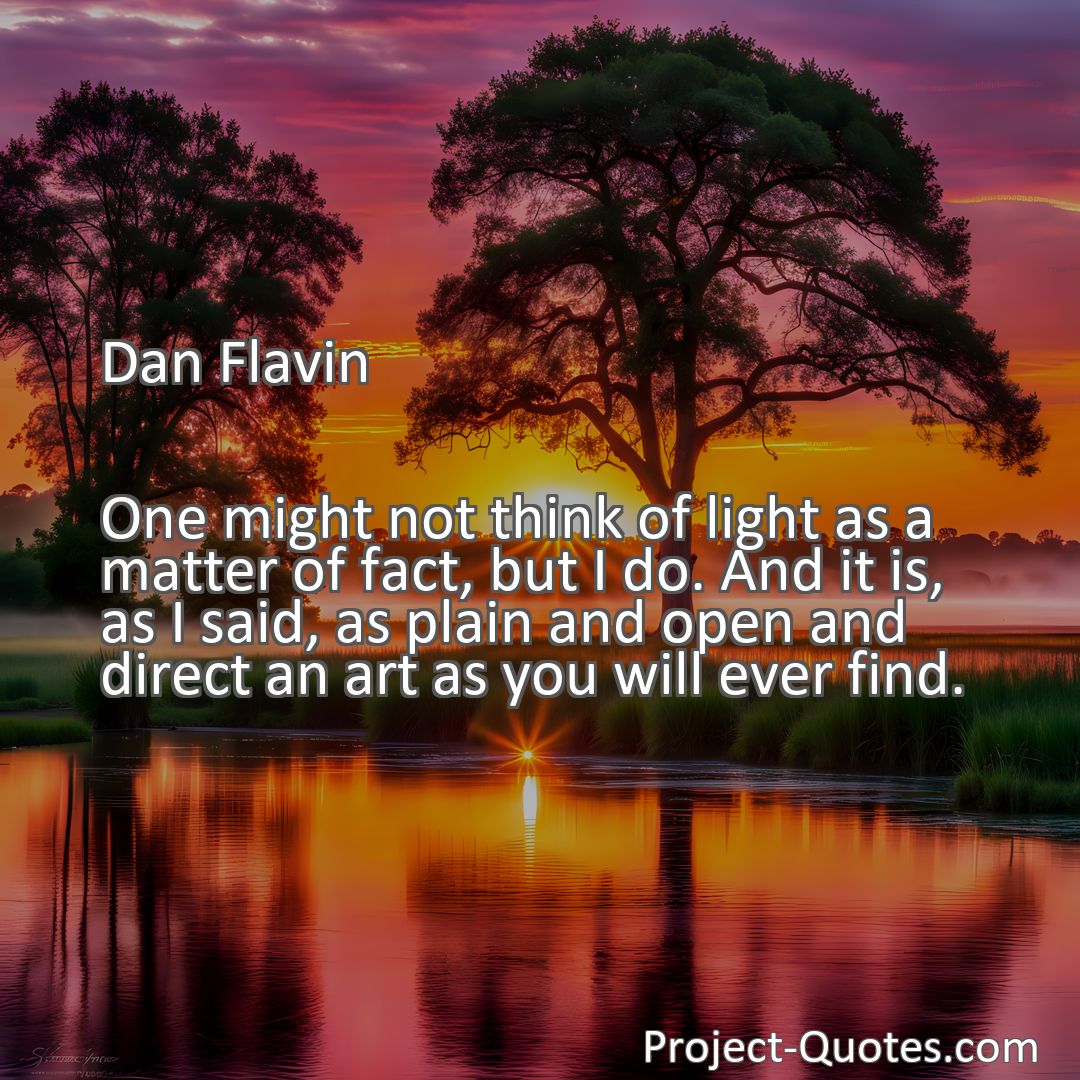One might not think of light as a matter of fact, but I do. And it is, as I said, as plain and open and direct an art as you will ever find.
Dan Flavin
Discover the Transformative Power of Light with Dan Flavin’s Unconventional Artistic Expression. Flavin, an artist who challenged traditional notions of art, found inspiration in something seemingly ordinary – light. Through his innovative use of fluorescent lights, Flavin created immersive sculptures, transforming galleries into vibrant experiences and encouraging viewers to find beauty in the mundane. His legacy continues to inspire artists today, showcasing the powerful beauty that can be found in the most unexpected places.
Table of Contents
- 1 One might not think of light as a matter of fact, but I do. And it is, as I said, as plain and open and direct an art as you will ever find.
- 2 Dan Flavin
- 3 Meaning of Quote – One might not think of light as a matter of fact, but I do. And it is, as I said, as plain and open and direct an art as you will ever find.
- 4 Freely Shareable Quote Image
- 5 Related
Meaning of Quote – One might not think of light as a matter of fact, but I do. And it is, as I said, as plain and open and direct an art as you will ever find.
Have you ever stopped to truly appreciate the beauty and simplicity of light? You may not think of it as a matter of fact, but I certainly do. In fact, light is an art form in itself. It is as plain and open and direct as any art you will ever come across. These profound words were spoken by the talented artist, Dan Flavin.
For centuries, artists have expressed their creativity and emotions through various mediums such as paint, sculpture, and photography. However, Flavin found his artistic inspiration in something seemingly ordinary light. He believed that light possesses a unique quality that can elicit powerful emotions and transform our perception of space. Through his innovative use of fluorescent lights, Flavin challenged traditional notions of art and pushed the boundaries of what is considered artistic expression.
Flavin’s artistic journey began in the 1960s when he started experimenting with commercial fluorescent lights. He was fascinated by the simplicity and accessibility of this medium, which allowed him to create sculptures using only tubes of light. These sculptures, often referred to as “light installations,” became the signature style of Flavin’s work. By arranging the fluorescent tubes in different compositions and colors, he transformed the sterile environments of galleries and museums into vibrant and immersive experiences.
One of Flavin’s most well-known works is his series “Monuments for V. Tatlin.” Inspired by the Russian Constructivist artist Vladimir Tatlin, Flavin created a series of sculptures that paid homage to Tatlin’s visionary designs. By incorporating Tatlin’s ideas into his own light installations, Flavin bridged the gap between two seemingly unrelated art movements and explored the interconnectedness of artistic expression across time and space.
Flavin’s use of light as the primary medium for his art challenged traditional notions of what constitutes a work of art. He believed that art should not be confined to canvas or sculpture alone but should transcend these boundaries and be accessible to everyone. In this sense, Flavin’s installations embraced the democratic nature of light, as it is a medium that is universally experienced and understood by people from all walks of life.
Furthermore, Flavin’s art raises questions about our perception of space and our relationship with the environment. By illuminating and transforming architectural spaces, his light installations altered our perception of the physical world around us. The play of light and shadow, the interaction of colors, and the interplay between the artwork and the surrounding space all worked together to create an immersive and thought-provoking experience for viewers.
Flavin’s works not only challenged the conventional boundaries of art but also questioned the role of the gallery or museum as the exclusive space for artistic experience. His use of industrial materials, such as fluorescent lights, brought art out of the traditional white cube environment and into the everyday world. By doing so, Flavin democratized art and invited viewers to reconsider their surroundings and find beauty in the mundane.
In addition to his artistic contributions, Flavin’s work also resonates with broader social and cultural movements of his time. The 1960s and 1970s were marked by political and social upheaval, and many artists sought to challenge the establishment and question existing power structures. Flavin’s use of unconventional materials and rejection of traditional artistic norms aligns with the spirit of artistic rebellion that defined the era.
Flavin’s legacy continues to inspire artists today. His innovative use of light as a medium has opened up new possibilities for artistic expression. Artists working in various disciplines, from photography to installation art, have been influenced by Flavin’s exploration of the transformative power of light. His emphasis on accessibility and the democratization of art serves as a reminder that art should not be limited to the elite few but should be accessible and relatable to all.
In conclusion, Dan Flavin’s quote about light as a matter of fact speaks to the profound impact that light can have as an art form. Through his innovative use of fluorescent lights, Flavin challenged traditional notions of what constitutes art and transformed our perception of space. His work not only pushed the boundaries of artistic expression but also addressed broader social and cultural movements of his time. Flavin’s legacy as an artist continues to inspire and influence contemporary artists, reminding us of the simple yet powerful beauty that can be found in the most unexpected places.
I hope this quote inspired image brings you hope and peace. Share it with someone who needs it today!


